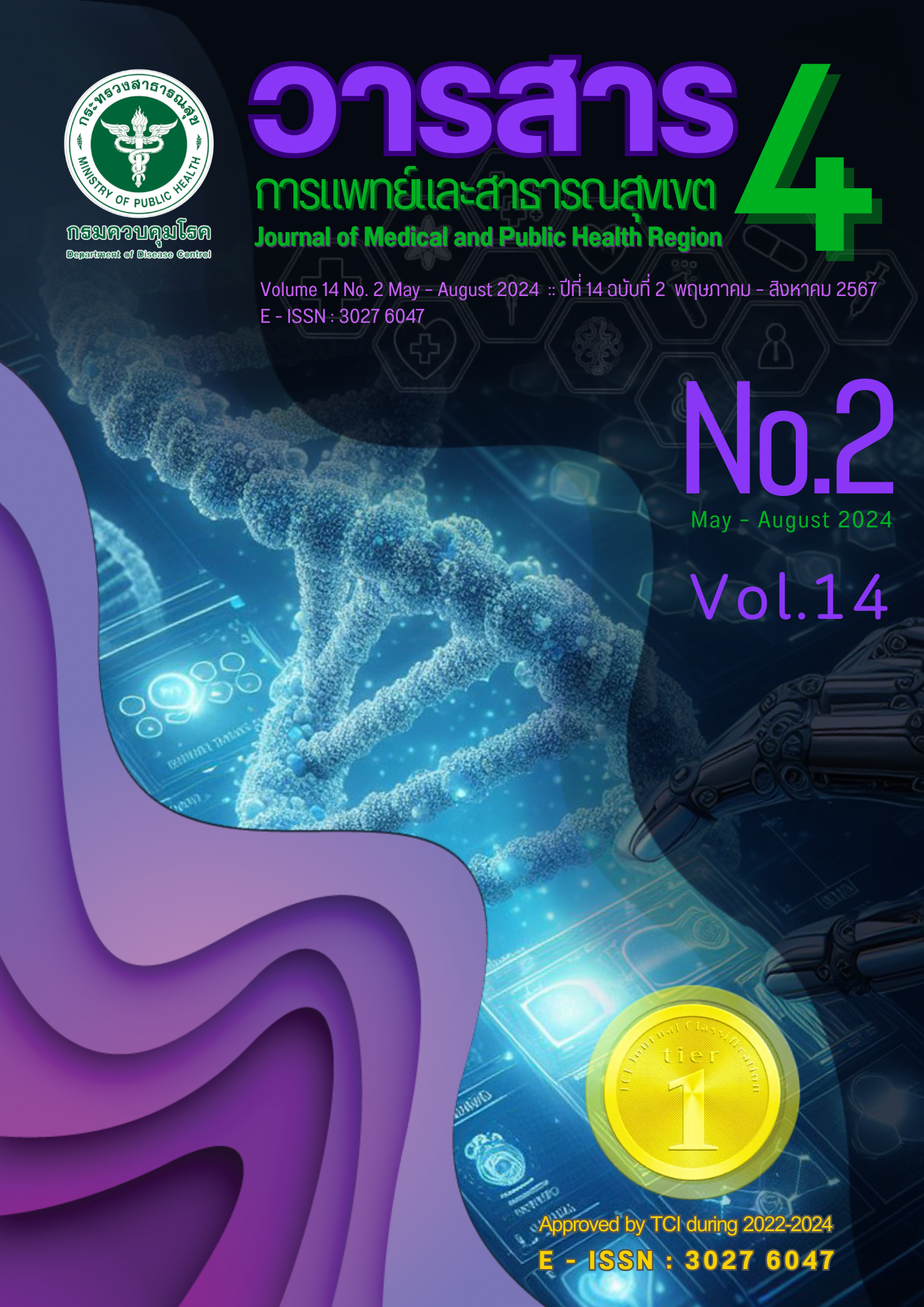Work ability and related factors among registered nurse in inpatient departments in a university hospital, Thailand
Main Article Content
Abstract
Registered nurses working in inpatient departments are responsible for caring for patients receiving overnight treatment in the hospital. This role demands professional skills and the ability to cope with uncertain working hours and conditions. Therefore, assessing and maintaining the work ability of nurses in inpatient departments is crucial. The objective of this study was to evaluate the level of work ability and assess the factors associated with it among nurses working in the inpatient departments of a university hospital in Thailand. The study was a cross-sectional study. Information on nurses was collected through a questionnaire survey. Exposure factors, including heat, light, and noise, were measured using standard methods. Cluster random sampling was employed to select the study population. Descriptive statistics and ordinal logistic regression analyses were conducted. A total of 374 registered nurses working in the inpatient departments participated in the study. The average work ability index was 32.8 points out of 49 points, and 78.8% of participants were categorized as having a moderate level of work ability. The factors associated with better work ability were age 45 years old and older (ORadj = 3.73, 95%CI = 1.31 - 10.86), an average monthly income of more than 50,000 baht (ORadj = 5.31, 95%CI = 1.72 - 16.87), and working beyond one's self-capacity (ORadj = 0.38, 95%CI = 0.20 - 0.71). To maintain the work ability of registered nurses, the hospital administrative team should consider and adjust the workforce of registered nurses to ensure the proper distribution of the workload. Additionally, policymakers should pay more attention to newly registered nurses in order to maintain and promote their work ability, enabling them to continue working effectively and happily.
Article Details

This work is licensed under a Creative Commons Attribution-NonCommercial-NoDerivatives 4.0 International License.
References
World Health Organization. Nursing and midwifery. [Internet]. Geneva: World Health Organization; 2022 [cited 2022 Jun 6]. Available from: https://www. who.int/news–room/fact–sheets/detail /nursing–and–midwifery
World Health Organization. State of the world’s nursing 2020: investing in education, jobs and leadership [Internet]. Geneva: World Health Organization; 2020 [cited 2022 Jun 4]. Available from: https://www.who.int/publications-detail-redirect /9789240003279
World Health Organization. Regional Office for Europe. Nurse workforce sustainability in small countries: monitoring mobility, managing retention. Policy brief 2022. [Internet]. Geneva: World Health Organization; 2022 [cited 2022 Jun 4]. Available from: https://apps.who.int/iris/handle/10665/351507
National Statistical Office (TH). Ratio of health personnel per population 2009 – 2021. [Internet]. [cited 2023 Jul 15]. Available from: http://ittdashboard.nso.go.th/preview2.php?id_project=60
Health Workforce Policy and Strategy Coordination Group. Human Resource Management Division, Office of the Permanent Secretary, Ministry of Health. Manpower reform plan and health service mission of the Ministry of Health. Nonthaburi: Tawan Media Publishing; 2019. P. 47–99
Gould R, Ilmarinen J, Järvisalo J, Koskinen S, editors. Dimensions of work ability results of the health 2000 survey. [Internet] . [cited 2018 November 30] . Available from: http://citeseerx.ist.psu.edu/viewdoc/ download?doi=10.1.1.823.7938&rep=rep1&type=pdf.
Chiu MC, Wang MJ, Lu CW, Pan SM, Kumashiro M, Ilmarinen J. Evaluating work ability and quality of life for clinical nurses in Taiwan. Nurs Outlook 2007; 55(6): 318–26.
Tangsathajaroenporn W, Kaewthummanukul T, Sripusanapan A. Work ability among professional nurses in a university hospital and related factors. Nursing Journal 2012; 39(4): 152–68. (in Thai).
Ilmarinen J, Tuomi K, Klockars M. Changes in the work ability of active employees over an 11–year period. Scand J Work Environ Health 1997; 23(Suppl 1): 49–57.
Fischer FM, Borges FN, Rotenberg L, Latorre Mdo R, Soares NS, Rosa PL, et al. Work ability of health care shift workers: what matters? Chronobiol Int 2006; 23(6): 1165–79.
Vasconcelos SP, Fischer FM, Reis AO, Moreno CR. Factors associated with work ability and perception of fatigue among nursing personnel from Amazonia. Rev Bras Epidemiol 2011; 14(4): 688–97.
Rostamabadi A, Zamanian Z, Sedaghat Z. Factors associated with work ability index (WAI) among intensive care units’ (ICUs’) nurses. J Occup Health 2017; 59(2): 147–55.
Golubic R, Milosevic M, Knezevic B, Mustajbegovic J. Work–related stress, education and work ability among hospital nurses. Journal of Advanced Nursing 2009; 65(10): 2056–66.
Žmauc T, Železnik D, Težak O. Work ability index in Slovenian hospital nurses aged over fifty years. Arh Hig Rada Toksikol 2019; 70(4): 265–72.
Sabutr P. Correlation of mental health, working environment and work ability of professional nurses in hospitals under public health ministry, Pathum Thani province. EAU Heritage Journal Science and Technology 2014; 8(1): 171–83. (in Thai).
Phakthongsuk P. Construct validity of the Thai version of the job content questionnaire in a large population of heterogeneous occupations. J Med Assoc Thai 2009; 92(4): 564–72.
Tuomi K, Ilmarinen J, Jahkola A, Katajarinne L, Tulkki A. Work ability index. 2nd ed. Helsinki: Finnish Institute of Occupational Health; 1998.
The Thai version of Effort–Reward Imbalance Questionnaire (Thai ERIQ): a study of psychometric properties in garment workers. J Occup Health 2008; 50(6): 480–91.
Van Buuren, S., Groothuis–Oudshoorn, K. (2011). mice: Multivariate Imputation by Chained Equations in R. Journal of Statistical Software; 45(3): 1–67. doi:10.18637/jss.v045.i03
Brant R. Assessing Proportionality in the Proportional Odds Model for Ordinal Logistic Regression. Biometrics. 1990; 46(4): 1171–8.
Ilmarinen J. From Work Ability Research to Implementation. International Journal of Environmental Research and Public Health 2019; 16: 2882.


